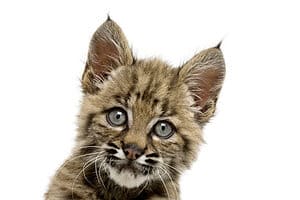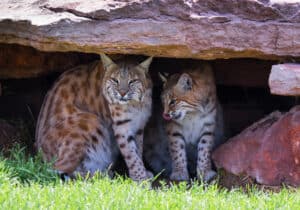The bobcat is a medium-sized wild cat that ranges from southern Canada to southern Mexico, with the majority roaming the continental United States. The bobcat is remarkably adaptable and can be found in forests, mountain woodlands, swamps, desert scrublands, and even suburban areas. Given the variety of environments where bobcats are found, they must be able to navigate various terrains. But can they climb trees?
Yes, bobcats can climb trees.

This bobcat climbed a Wisconsin poplar tree in the winter.
©iStock.com/Michael-Tatman
Built to Climb
The bobcat has muscular legs. Its powerful back legs are longer than its front legs, which gives the cat extraordinary leaping ability. The cat can leap ten feet into the air, the same height as a standard basketball rim. Those muscular legs can also power a bobcat up a tree.
The cat is relatively lightweight, too. An adult female can weigh up to 30 pounds, while a male normally weighs around 35 pounds. It’s no problem for this powerful cat to haul its mid-sized frame up a tall tree.

Bobcats have powerful legs that they use to leap and climb.
©Chris Desborough/Shutterstock.com
Why Do Bobcats Climb Trees?
There are a few reasons why a bobcat will climb a tree.
Escape
Mature bobcats have relatively few natural predators. Mountain lions and wolves are among the few predators that will take on an adult bobcat.
A bobcat will scale a tree to escape a potential threat. Along with natural predators, domestic dogs will often send bobcats to the treetops.
Kittens are far more vulnerable than adult bobcats. Coyotes, foxes, and even owls will predate young bobcats.
Hunting
Bobcats will also climb trees to hunt prey. Most of the cat’s prey, such as hares, rabbits, and rodents, are confined to the ground. When smaller prey is unavailable, a bobcat will even target deer, an animal much larger than the cat itself.
Sometimes bobcats will climb trees for the element of surprise. If a bobcat can wait quietly in a tree until a prey animal, such as a hare, comes within range, it can then pounce from above. It is a highly effective hunting strategy.
Also, while most of its prey is found on the ground, this wild cat will sometimes hunt in the treetops. Bobcats are known to predate squirrels and birds. A bird nest full of eggs is an especially easy meal and quite a tempting reason for a bobcat to climb a tree.

Bobcats often predate small mammals such as rodents.
©gobirdnerds/Shutterstock.com
Rest
For a medium-sized cat, the bobcat has a surprisingly large home range. A female bobcat’s range can cover roughly five square miles, while a male’s range can extend upwards of 30 square miles. Territorial disputes are rare. The cats scent-mark their territory, and other cats generally respect those boundaries.
With such a large range to cover, sometimes bobcats need to find a place to rest. If they are away from the multiple dens in their territory, bobcats will sometimes climb a tree to rest. Bobcats even sleep in trees from time to time, although it’s usually just a catnap, so to speak.

Sometimes bobcats will climb a tree to rest.
©WhirlVFX – Pamela Werrell/Shutterstock.com
An Elusive Cat
Even though bobcats are skilled climbers, it is pretty unlikely you’ll see one in a tree outside your window. Bobcats are solitary, secretive creatures that seem to go out of their way to avoid drawing attention to themselves.
While they can be active any time of day, bobcats are mainly crepuscular and nocturnal hunters. This drastically reduces the number of human/bobcat interactions. A bobcat may patrol your locality without you ever knowing it.
You are more likely to hear a bobcat than to see one. Bobcats mew, much like domestic cats. They also purr, snarl, hiss, chirp, yowl, and scream. Hearing these sounds in the woods at night is enough to make even experienced outdoorsmen and outdoorswomen shiver.
You are also more likely to find bobcat tracks than actually to see a bobcat. Since the bobcat’s claws are retractable, their footprints have no claw impressions. The prints can be one to three inches across, depending on the size and age of the cat. Their front feet are just slightly bigger than their rear feet. Bobcats direct register when they walk, meaning their back feet land in the footprints of their front feet. This allows the stealthy cat to approach its prey quietly.
Bobcats have been documented in every state in the continental U.S. except Delaware. The cat was extirpated from Delaware in the nineteenth century, and there has been no documented bobcat population since.
While it is unlikely, it’s not impossible to see a bobcat on your next hike through the woods. Take a look up in the trees. You never know what you might find!

Bobcat tracks have no claw imprints since the cat’s claws are retractable.
©Bobcat tracks in the mud/Shutterstock.com
The photo featured at the top of this post is © iStock.com/brentawp
Thank you for reading! Have some feedback for us? Contact the AZ Animals editorial team.






